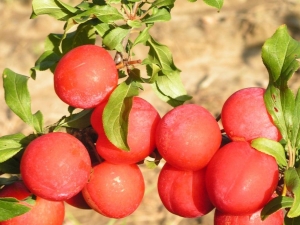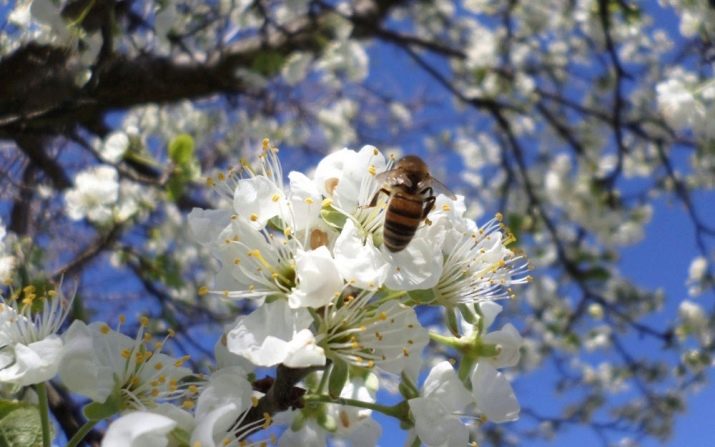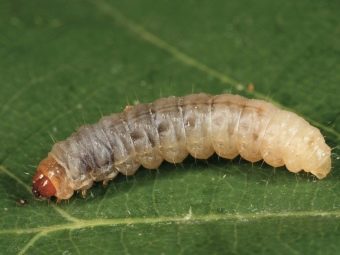Skoroplodnaya plum: characteristics of the variety, cultivation and care

Fruit trees are a real decoration of the garden plot. At the time of flowering buds showered thick green crowns, spreading around the delicate aroma.In addition, the fruits that fruit gardeners generously give fruit crops, are very healthy and tasty. Plum is one of the most popular and relatively unpretentious species of fruit trees. The article focuses on the popular variety Skoroplodnaya.
Description
This type of plum is a subtype of "Chinese". Skoroplodnaya was bred at the end of the 50s of the last century by crossing two varieties of plums: Ussuri red and Climax. Employees of the All-Russian Plant Breeding and Technological Institute of Horticulture and Nursery Enikkev Kh. K. and Satarova S.N.
The introduction of the variety in agriculture and gardening began actively in 1965. The plum was zoned on the territory of the Moscow Region, the Central Black Earth Region and in the coastal region.
At the moment, this plum variety is successfully cultivated in almost all regions of our country, not excluding the territory of Siberia. Fruit culture varieties "Skoroplodnaya" fully justifies its name very early and abundant harvests of excellent plums.
The young seedling usually successfully takes root and is able to give the first harvest in the third year after disembarking to a permanent place. On average, the longevity and active fruiting of a tree is 20–25 years.
For fruiting plum of this type need pollinators.
The crop yield is about 9 kg of fruit from one adult tree. Fruiting is periodic. Plum "rests" every 2-3 years, not bearing fruit.
Plum variety "Skoroplodnaya" has a high frost resistance. The culture tolerates a drop in temperature down to -40 ° C. Drought tolerance rates are above average.
The variety has good immunity to diseases and pests. In particular, it is not susceptible to damages with perforated spot foliage (cloisters). Fruit rot can be affected by weakened trees. From pests on plum can attack aphid and moth.
Diploid plum "Apricot" has very similar characteristics.
Before acquiring any fruit shrub, including the Skoroplodnaya variety, need to familiarize yourself with its features.
- The crop shoots have a red-brown color, smooth and shiny soft skin. The buds develop rejected from the main shoot.
- Mature trees are usually low: the maximum height is about 2–2.5 meters. The krone has a rounded shape, very sprawling. Olivation of average density.
- The leaves are small in size, light green. They have a shape that is very similar to the foliage of a peach tree. Leaf plate oblong and wavy at the edges, smooth on both sides, without hairs and pubescence.
- Flowers of white color are collected in small inflorescences and are located on the bouquet sprigs. From one bud develops up to 3 flowers. Petals are closed, on buds there are many stamens.
- The flowering is quite early: most often falls on the first days of May. Usually at a site this variety, under favorable conditions, dispenses buds before all other fruit trees. In the case of early and warm spring, flowers can bloom simultaneously with the leaves or even a little earlier.
Similarly, before buying, you need to find out the characteristics of the fruits of the tree that you want to plant on your plot, so that you will not be disappointed in the grown berries.
- Plums growing on the same tree may have a different color. Pale peach color is characteristic for fruits of medium ripeness. The most ripe plums get bright orange and red colors. Crop ripening occurs at the beginning of August.
- Fruits have medium size, rounded shape. The pubescence on the skin plums is missing. Fruit weight 20–30 grams. The abdominal suture, characteristic of plums, is weakly expressed in this variety.
- The peel of the fruit is thickened and elastic. It has a layer of thin wax.
- The flesh is bright yellow, very juicy and fleshy.
- The bones are rather large, weighing 0.5–0.7 grams. They are separated from the pulp with difficulty. But the fruit stem departs very easily.
- Plums have a high appreciation of taste from tasters. It is equal to 4.5 points. Fruits produce a pleasant and rich plum aroma, have a sweet and sour taste. The sugar content in the fruits is low. Variety is considered to be dessert.
- Chemicals contained in fruits: free acids (2.21%), sugars (8.8%), ascorbic acid (10 mg per 100 grams of plums). The total solids content is 13.5%.
- Harvest has an average level of transportability. It is extremely untransportable in late maturity.
The advantages of the variety "Early":
- high and early yield;
- excellent taste of the fruit;
- attractive marketable appearance and good crop transportability;
- at low temperatures, the fruits tolerate long-term storage without loss of quality;
- frost resistance and drought resistance.
Weaknesses and disadvantages:
- with abundant flowering and a large number of ovaries, the fruit can significantly lose in size and weight, in other words, plums can grind;
- bark may be affected by direct sunlight;
- yield cycle: the crop does not produce fruit one season every 2-3 years, after which the fruiting is resumed.
How to get a good harvest?
For planting a seedling, it is advisable to choose a sunny place on a garden plot: the culture is developing poorly in lowlands and shaded places. A good condition is also to provide protection from the wind from the north (for example, a fence or any structure).
Clay soils are undesirable for planting a plum tree. Also, the culture does not tolerate oversaturated lands with groundwater and soils with stagnant moisture in the upper layers.
Planting can be made in the fall and spring. In the case of a spring planting, a well under the plant is prepared from autumn. To do this, the soil is mixed with organic and mineral supplements.
The pit for a young tree should be made large enough. It should hold up to 10 liters of soil mixed with fertilizer.
After planting, the root zone of the soil around the seedling needs to be watered abundantly. Then you can sprinkle the area around the tree with peat, dry hay or sawdust: this will reduce the evaporation of moisture from the upper layers of soil.
Plum "Skoroplodnaya" in general is not particularly capricious in the care. This is evidenced by reviews of gardeners who chose this variety for growing on the site.
In the early years, the seedling must be provided with regular watering. A stronger young tree can tolerate short periods of drought. But in the absence of precipitation for a long time and significant drying out of the soil, it is still necessary to water the drain additionally.
As a top dressing plum well takes fertilizers with nitrogen. The introduction of nutrients can be carried out 2-3 times a year. The first time feeding is done before flowering. The second fertilization should be done after the fruit appears on the branches. To strengthen the immunity of the plant before winter after the harvest, you can spend the last autumn feeding plums.
Like most crops, plums love regular soil loosening.
Early spring should be thinned pruning to form a crown. At the same time, damaged, weakened and broken branches are removed.
Diseases and pests
Plum can be affected by moniliasis. Young trees that are not yet mature or weakened are especially weakly resistant to it. For the prevention of this scourge you need to sprinkle the crown and trunk with a 3% solution of Bordeaux liquid before the first buds bloom.
Effective remedies for destroying the moth are Feramon's traps. It is also permissible to spray the tree with chemical compounds.
Review this and other popular varieties of plums, see the following video.
































